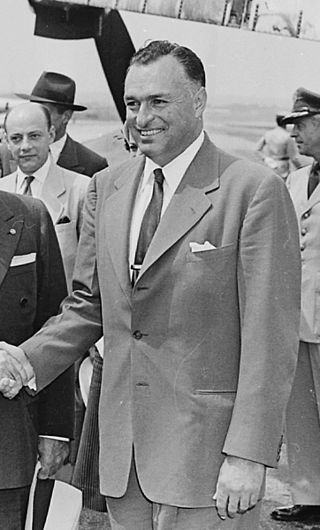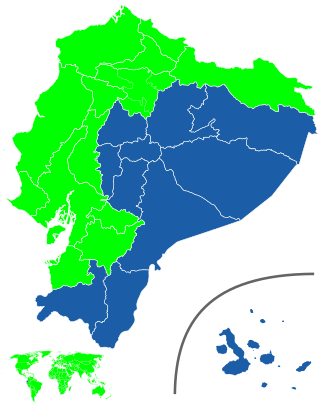The History of Ecuador covers human habitation in the region reaching back 8,000 years

The politics of Ecuador are multi-party. The central government polity is a quadrennially elected presidential, unicameral representative democracy. The President of Ecuador is head of state and head of the army on a multi-party system, and leads a cabinet with further executive power. Legislative power is not limited to the National Assembly, as it may to a lesser degree be exercised by the executive which consists of the President convening an appointed executive cabinet. Subsequent acts of the National Assembly are supreme over Executive Orders where sufficient votes have been cast by the legislators. The judiciary is independent of the executive and the legislature. Ecuador is also considered a constitutional republic.

Sixto Alfonso Durán-Ballén Cordovez was an Ecuadorian political figure and architect. He served as Mayor of Quito between 1970 and 1978. In 1951, he co-founded a political party, the Social Christian Party. In 1991, he left the Social Christian Party and formed a new conservative group, the Republican Union Party (PUR), before running for president for the third time in 1992.

José María Velasco Ibarra was an Ecuadorian politician. He became president of Ecuador five times, in 1934–1935, 1944–1947, 1952–1956, 1960–1961, and 1968–1972, and only in 1952–1956 he completed a full term. In his four other terms, he was removed by military force, and several times he was installed as president through a military coup.

Galo Lincoln Plaza Lasso de la Vega was an Ecuadorian statesman who served as President of Ecuador from 1948 to 1952 and Secretary General of the Organization of American States from 1968 to 1975. He is the son of former Ecuadorian President Leonidas Plaza.

The president of Ecuador, officially called the constitutional president of the Republic of Ecuador, serves as the head of state and head of government of Ecuador. It is the highest political office in the country as the head of the executive branch of government. Per the current constitution, the president can serve two four-year terms. Prior to that, the president could only serve one four-year term.

Otto Arosemena Gómez was President of Ecuador from 16 November 1966 to 1 September 1968.

The Revolutionary and Democratic Ethical Green Movement (MOVER, Spanish: Movimiento Verde Ético Revolucionario y Democrático) is a centre to centre-right neoliberal and environmentalist political party in Ecuador. In 2016, it had 979,691 members. Until 2021 it was known as the PAIS Alliance (Proud and Sovereign Homeland) (PAIS, Spanish: Alianza PAIS (Patria Altiva i Soberana)).

This is a summary of the history of Ecuador from 1860 to 1895. Gabriel García Moreno is the father of Ecuadorian conservatism and no doubt the most controversial figure in the nation's history, condemned by Liberal historians as Ecuador's worst tyrant but exalted by Conservatives as the nation's greatest nation-builder. In the end, both appraisals may be accurate; the man who possibly saved Ecuador from disintegration in 1859 and then ruled the nation with an iron fist for the subsequent decade and a half was, in fact, an extremely complicated personality. Born and raised under modest circumstances in Guayaquil, he studied in Quito, where he married into the local aristocracy, then traveled to Europe in the aftermath of the 1848 revolutionary uprisings and studied under the eminent Catholic theologians of the day.

This is a summary of the history of Ecuador from 1895-1925. Eloy Alfaro is the outstanding standard-bearer for Ecuador's Liberals, much as Gabriel García Moreno is for the Conservatives. Some Marxist groups have also looked to Alfaro; although his political program was in no way socialist, it did prove to be revolutionary in the extent to which it stripped the Roman Catholic Church of the power and privileges previously granted to it by García Moreno. Catholic officials and their Conservative allies did not give up without a fight, however. During the first year of Alfaro's presidency, Ecuador was ravaged by a bloody civil war in which clergymen commonly incited the faithful masses to rise in rebellion against the "atheistic alfaristas" and were, just as commonly, themselves victims of alfarista repression. The foreign-born Bishops Pedro Schumacher of Portoviejo and Arsenio Andrade of Riobamba led the early resistance to Alfaro. A fullfledged bloodbath may well have been averted only through the magnanimous efforts of the outstanding historian and Archbishop Federico González Suárez, who urged the clergy to abandon the pursuit of politics.

This is a summary of the history of Ecuador from 1925 to 1944.

The history of the Republic of Ecuador from 1960 to 1990 encompasses a period of political, social, and economic changes in the country. During this time, Ecuador experienced military regimes, political instability, social movements, and economic challenges.

Carondelet Palace is the seat of government of the Republic of Ecuador, located in Quito. Access is by the public space known as Independence Square or Plaza Grande, around which are also the Archbishop's Palace, Municipal Palace, Hotel Plaza Grande, and Metropolitan Cathedral.
The Conservative Party was an Ecuadorian conservative party formed in 1869. Initially associated with the military of Ecuador the PC became one of the two great parties of state in the country, alternating in power with the Ecuadorian Radical Liberal Party. Its traditional support basis has been amongst the landowning classes, as well as merchants and artisans and it tended to favour a unitary structure rather than federalism.
Ecuador is a country in South America.

Assad Bucaram Elmhalin was an Ecuadorian politician who occupied positions as city Councilor and later of Mayor of Guayaquil. He was elected a Deputy for the province of Guayaquil and was later appointed President of the National Assembly of Ecuador.

Luis Ramón Félix López was an Ecuadorian doctor, politician and renowned writer who held many senior public positions in his country during his lifetime.

General elections were held in Ecuador on 19 February 2017 alongside a referendum on tax havens. Voters elected a new President and National Assembly. Incumbent President Rafael Correa of the PAIS Alliance was not eligible for re-election, having served three terms. In the first round of the presidential elections, PAIS Alliance candidate Lenín Moreno received 39% of the vote. Although he was more than 10% ahead of his nearest rival, Guillermo Lasso of the Creating Opportunities party, Moreno was just short of the 40% threshold required to avoid a run-off. As a result, a second round was held on 2 April. In the second round Moreno was elected president with 51.16% of the vote.

The 2019 Ecuadorian protests were a series of protests and riots against austerity measures including the cancellation of fuel subsidies, adopted by President of Ecuador Lenín Moreno and his administration. Organized protests ceased after indigenous groups and the Ecuadorian government reached a deal to reverse the austerity measures, beginning a collaboration on how to combat overspending and public debt.
The Julian Revolution1 was a civic-military movement in Ecuador that, through a coup on July 9, 1925 led by the Military League, a secret group of young officers of the Ecuadorian Army, overthrew President Gonzalo Córdova. After an initial Military Junta, it was extended for six years —until 1931—, with two provisional government juntas and the presidency of Isidro Ayora, first interim and then constitutional, which ended with a new military coup on August 24, 1931.


















